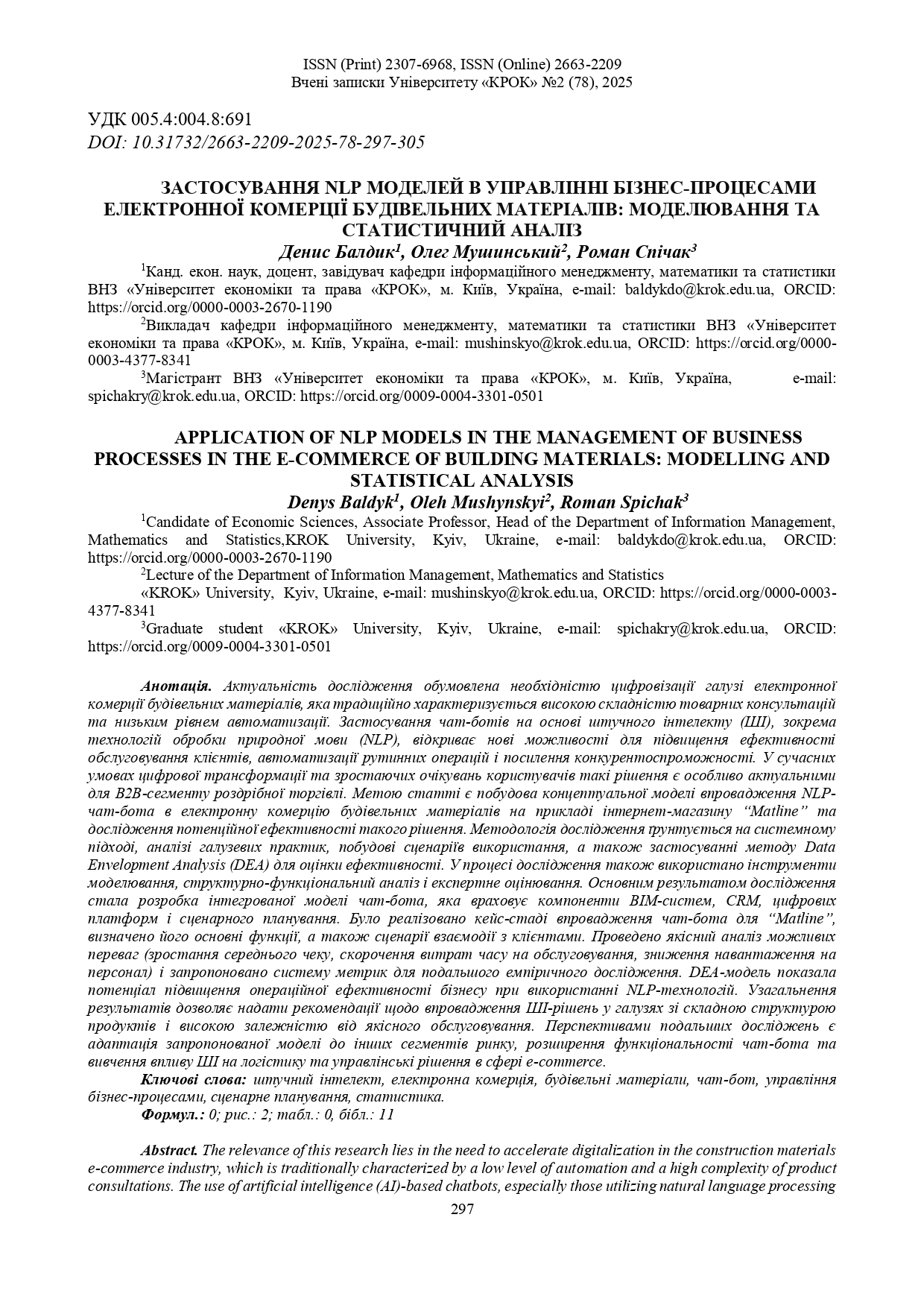APPLICATION OF NLP MODELS IN THE MANAGEMENT OF BUSINESS PROCESSES IN THE E-COMMERCE OF BUILDING MATERIALS: MODELLING AND STATISTICAL ANALYSIS
DOI:
https://doi.org/10.31732/2663-2209-2025-78-297-305Keywords:
artificial intelligence, e-commerce, construction materials, chatbot, business process management, scenario planning, statisticsAbstract
The relevance of this research lies in the need to accelerate digitalization in the construction materials e-commerce industry, which is traditionally characterized by a low level of automation and a high complexity of product consultations. The use of artificial intelligence (AI)-based chatbots, especially those utilizing natural language processing (NLP) technologies, provides new opportunities for improving customer service efficiency, automating routine tasks, and enhancing competitiveness. Under current conditions of digital transformation and increasing customer expectations, such solutions are particularly relevant for the B2B retail segment. The aim of this article is to develop a conceptual model for implementing an NLP-based chatbot in the construction materials e-commerce sector, using the online store “Matline” as a case study, and to assess the potential efficiency of such an initiative. The methodology combines a systems approach, analysis of industry practices, scenario modeling, and the use of the Data Envelopment Analysis (DEA) method for measuring efficiency. Additional tools include modeling, structural-functional analysis, and expert evaluation. The main result of the research is an integrated chatbot model that incorporates BIM systems, CRM, digital platforms, and scenario planning. A practical case study of the chatbot implementation for “Matline” was conducted, outlining its core functions and user interaction scenarios. The study provides a qualitative assessment of expected benefits (such as an increase in average check size, reduced service time, and lower employee workload) and proposes a set of performance metrics for future empirical validation. The DEA model revealed the potential for improved operational efficiency through the use of NLP-based tools. The conclusions offer recommendations for AI integration in industries with complex product structures and a strong need for high-quality service. Future research will focus on adapting the proposed model to other market segments, expanding chatbot functionality, and examining the influence of AI on logistics and managerial decision-making in e-commerce.
Downloads
References
Боголій, О. (2024). Вдосконалення управління знаннями в організації за допомогою NLP моделей. Вчені записки Університету «КРОК», (2(74), 178–184). DOI: https://doi.org/10.31732/2663-2209-2024-74-178-184
Бушуєв, С., Ільїн, О., Пузійчук, А., & Лященко, Т. (2025). Інтеграція штучного інтелекту в бази знань управління інноваційними проєктами. Управління розвитком складних систем, (61), 42–51. DOI: https://doi.org/10.32347/2412-9933.2025.61.42-51
Charnes, A., Cooper, W. W., & Rhodes, E. (1978). Measuring the efficiency of decision making units. European Journal of Operational Research, 2(6), 429–444.
Chen, T.-C., & Kuo, F.-H. (2021). Assessing the operational performance of the transformation AI industry in Taiwan - Critical factors for the transition. Journal of Business and Management Sciences, 9(1), 50–57. DOI: 10.12691/jbms-9-1-6.
Juniper Research. (2022). Chatbot messaging app accesses to reach 9.5 billion globally by 2026 URL: https://www.juniperresearch.com/press/chatbot-messaging-app-accesses-to-reach-95-billion-globally-by-2026
Marjerison, R. K., Dong, H., Kim, J.-Y., Zhang, H., Zhang, Y., & Kuan, G. (2025). Understanding user acceptance of AI-driven chatbots in China’s e-commerce: The roles of perceived authenticity, usefulness, and risk. Systems, 13(2), 71. DOI: https://doi.org/10.3390/systems13020071
Rach, V., Rossoshanskaya, O., & Medvedieva, O. (2023). Management of different nature projects in the mind-economy of the bani-world. Information Systems in Project and Program Management. Press of the Kharkiv National University of Radioelectronics. DOI: https://doi.org/10.30837/mmp.2023.290
Rahevar, M., & Darji, S. (2024). The adoption of AI-driven Chatbots into a recommendation for e-commerce systems to targeted customer in the selection of product. International Journal of Management, Economics and Commerce, 1(2), 128–137. DOI: https://doi.org/10.62737/m1vpdq75
Романенко, О., Алавердян, Л., & Басова, Г. (2022). Використання чат-ботів у торгівлі будівельними матеріалами. Маркетинг і цифрові технології, 6(4), 7–16. DOI: 10.15276/mdt.6.4.2022.1
Россошанська, О. В. (2015). Підхід до формування системи оцінювання економічної безпеки інноваційних проектно-орієнтованих підприємств. Управління проектами та розвиток виробництва, (4), 124–145.
Sidlauskiene, J., Joye, Y., & Auruskeviciene, V. (2023). UAI-based chatbots in conversational commerce and their effects on product and price perceptions. Journal Name, 33(24). DOI: https://doi.org/10.1007/s12525-023-00633-8
SNS Insider Pvt. Ltd. (2022). Chatbot market. Retrieved May 29, 2025. URL: https://www.snsinsider.com/reports/chatbot-market-1240
Szaniawska-Schiavo, G., & Fokina, M. (2025). Chatbot Statistics: Trends and Insights. Tidio. URL: https://www.tidio.com/blog/chatbot-statistics
Venkata Siva Kumar, S., & Metta, S. (2025). AI-powered Customer Service: The Role of Chatbots in Enhancing E-commerce Interactions. In Navigating Data Science in the Age of AI: Exploring Possibilities of Generative Intelligence (pp. 67–82). Emerald Publishing Limited. DOI: https://doi.org/10.1108/978-1-83608-432-720251004
Williams, Z. (2025). Why Building Materials Distributors Need Chatbots. Venveo. URL: https://www.venveo.com/blog/why-building-materials-distributors-need-chatbots

Downloads
Published
How to Cite
Issue
Section
License

This work is licensed under a Creative Commons Attribution-NonCommercial 4.0 International License.

